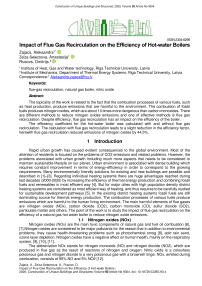Impact of flue gas recirculation on the efficiency of hot-water boilers
Автор: Zajacs Aleksandrs, Zeiza-Seleznova Anastasija, Rusovs Dmitrijs
Журнал: Строительство уникальных зданий и сооружений @unistroy
Статья в выпуске: 8 (93), 2020 года.
Бесплатный доступ
The topicality of the work is related to the fact that the combustion processes of various fuels, such as heat production, produce emissions that are harmful to the environment. The combustion of fossil fuels produces nitrogen oxides, which are about 10 times more dangerous than carbon monoxides. There are different methods to reduce nitrogen oxides emissions and one of effective methods is flue gas recirculation. Despite efficiency, flue gas recirculation has an impact on the efficiency of the boiler. The efficiency coefficient for the hot-water boiler was calculated with and without flue gas recirculation. The calculation with flue gas recirculation leads to a slight reduction in the efficiency factor, herewith flue gas recirculation reduced emissions of nitrogen oxides by 44,5%.
Flue-gas recirculation, natural gas boiler, nitric oxide
Короткий адрес: https://sciup.org/143172536
IDR: 143172536 | DOI: 10.18720/CUBS.93.4
Список литературы Impact of flue gas recirculation on the efficiency of hot-water boilers
- Korniyenko, S., Popova, E. "Green" construction in Russia and other countries. Construction of Unique Buildings and Structures. 2017. 55(4). Pp. 134. DOI: 10.18720/CUBS.55.5
- Gorshkov, Alexander Sergeevich Vatin, Nikolai Ivanovich Rymkevich, P.P. Climate change and the thermal island effect in the million-plus city. Construction of Unique Buildings and Structures. 2020. 89. DOI: 10.18720/CUBS.89.2
- Vilinskaya, A.O., Nemova, D.V., Davydova, E.I., Gnam, P.A. Rising the energy efficiency class of public building. Construction of Unique Buildings and Structures. 2015. 36(9). Pp. 7-17. DOI: 10.18720/CUBS.36.1
- Borodinecs, A., Bogdanovics, R., Prozuments, A., Tihana, J., Gaujena, B. Evaluation of hybrid heating systems with a combination of fossil and renewable energy sources. IOP Conference Series: Earth and Environmental Science. 2019. DOI: 10.1088/1755-1315/297/1/012050
- Zajacs, A., Borodiņecs, A. Assessment of development scenarios of district heating systems. Sustainable Cities and Society. 2019. DOI: 10.1016/j.scs.2019.101540
- Abián, M., Peribáñez, E., Millera, Á., Bilbao, R., Alzueta, M.U. Impact of nitrogen oxides (NO, NO2, N2O) on the formation of soot. Combustion and Flame. 2014.
- DOI: 10.1016/j.combustflame.2013.07.015
- Glarborg, P., Miller, J.A., Ruscic, B., Klippenstein, S.J. Modeling nitrogen chemistry in combustion, Progress in Energy and Combustion Science 2018.
- DOI: 10.1016/j.pecs.2018.01.002
- Korpela, T., Kumpulainen, P., Majanne, Y., Häyrinen, A. Model based NOx emission monitoring in natural gas fired hot water boilers. IFAC-PapersOnLine. 2015.
- DOI: 10.1016/j.ifacol.2015.12.409
- Batrakov, P.A. The Nitrogen Oxide Formation Studying at Natural Gas Combustion in Non-circular Profile Furnaces of Fire-tube Boilers. Procedia Engineering. 2016.
- DOI: 10.1016/j.proeng.2016.07.646
- Zeldovich, Y.B. Regime classification of an exothermic reaction with nonuniform initial conditions. Combustion and Flame. 1980.
- DOI: 10.1016/0010-2180(80)90017-6
- Zeldovich, Y.B. 26. Oxidation of Nitrogen in Combustion and Explosions. Selected Works of Yakov Borisovich Zeldovich, Volume I 2015,
- DOI: 10.1515/9781400862979.404
- Task Force on Techno-economic Issues. Reduction of NOx emissions. http://tftei.citepa.org/en/industrial-sources/reduction-of-nox-emissions#formation-process-in- combustion.
- Gholami, F., Tomas, M., Gholami, Z., Vakili, M. Technologies for the nitrogen oxides reduction from flue gas: A review, Science of The Total Environment, 2020.
- DOI: 10.1016/j.scitotenv.2020.136712
- Environmental Protection Agency (EPA). Nitrogen oxides (NOx), why and how they are controlled. Epa-456/F-99-006R. 1999. DOI:EPA 456/F-99-006R.
- Kröcher O., Selective catalytic reduction of NOx. Catalysts, MDPI, 2018,
- DOI: 10.3390/catal8100459
- Bell, R.D., Buckingham, F.P. An Overview of Technologies for Reduction of Oxides of Nitrogen from Combustion Furnaces. MPR Associates NOx Reduction Overview. 1990. https://api.semanticscholar.org/CorpusID:52025566
- Ballester, J.M., Dopazo, C., Fueyo, N., Hernández, M., Vidal, P.J. Investigation of low-NOx strategies for natural gas combustion. Fuel. 1997.
- DOI: 10.1016/S0016-2361(97)85521-4
- Lysova E., Paramonova O., Samarskaya N., Gyrova O., Tsarevskaya I., Application of physical and energetic approach to estimation and selection of atmospheric protection systems for energetic devices, MATEC Web of Conferences 170, 04013 (2018),
- DOI: 10.1051/matecconf/201817004013
- A.A.Khan, W. Jonga, P.J.Jansens, H.Spliethoff, Biomass combustion in fluidized bed boilers: Potential problems and remedies, Fuel Processing Technology, 2009,
- DOI: 10.1016/j.fuproc.2008.07.012
- Yu, B., Lee, S., Lee, C.E. Study of NOx emission characteristics in CH4/air non-premixed flames with exhaust gas recirculation. Energy. 2015.
- DOI: 10.1016/j.energy.2015.08.023
- Bosch. Bosch Thermotechnology2020, https://www.bosch- thermotechnology.com/corporate/en/company/production-sites/legal-notes-uk.html
- Men, Y., Liu, X., Zhang, T., Performance comparison of different total heat exchangers applied for waste heat recovery, Applied Thermal Engineering, 2021,
- DOI: 10.1016/j.applthermaleng.2020.115715


